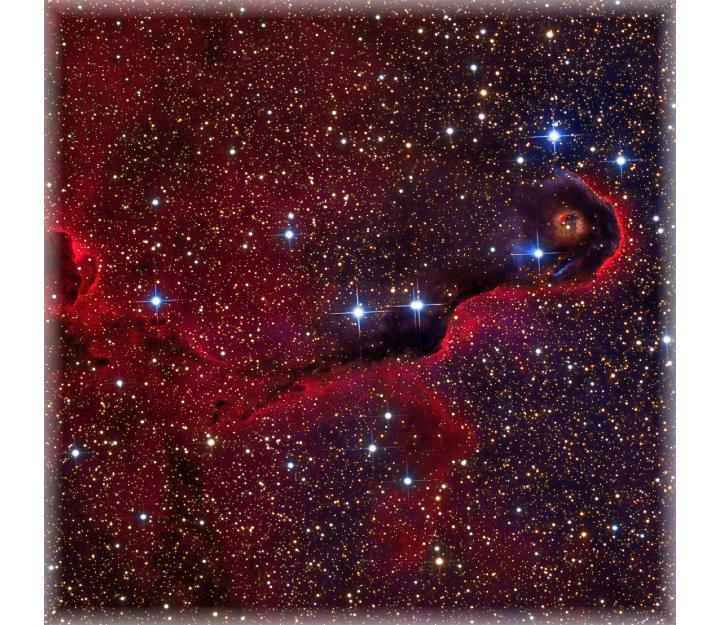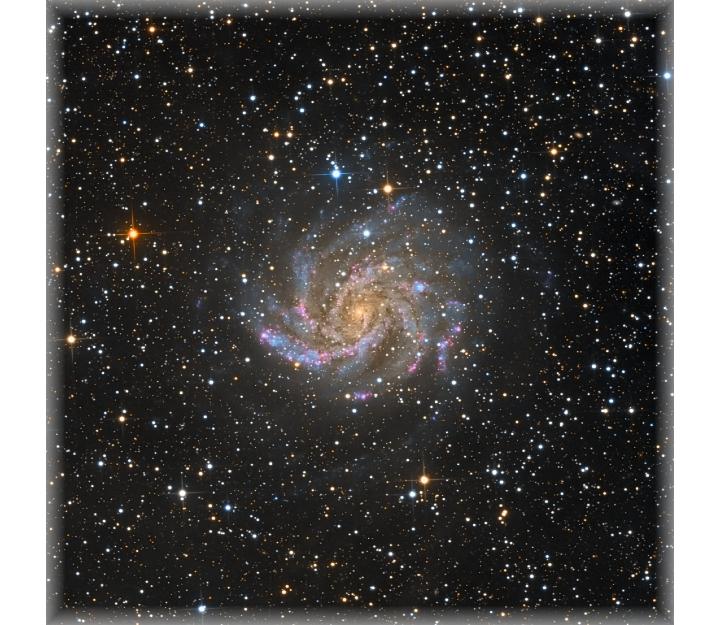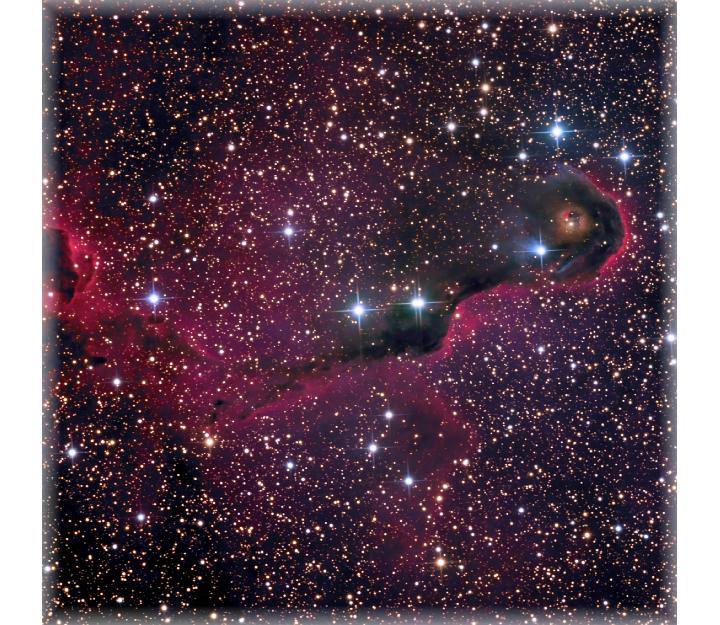 |
||
 |
||

IC 1396A (Elephant's Trunk) in Cepheus.
Imaged August 11-16 2011, 10 hours total.
L=300 minutes (1x1), R=100m, G=100m, B=100m (2x2). Subframes=10m.
NGC 6946 (Fireworks Galaxy) in Cepheus.
Imaged August 12-15 2011, 11- hours total.
L=310 minutes (1x1), R=120m, G=110m, B=110m (2x2). Subframes=10m.
Equipment / Image acquisition and processing
Telescope=PlaneWave CDK17, Camera=SBIG STL-4020M, Mount=Paramount ME.
PlaneWave focal reducer (f/4.5). Baader filters.
Frames acquired with TheSky 6, MaxIm DL, and Focusmax.
Processed with PixInsight and CCDInspector.
These marvels are found just above a celestial shoulder of the mythical king Cepheus, whose constellation rides high in night-time skies of summer and fall: IC 1396A, the Elephant's Trunk Nebula, and NGC 6946, the Fireworks Galaxy (also known as Caldwell 12). Despite their close proximity on the sky, separated by only eight degrees, and lying within a dozen degrees of the plane of the Milky Way, they are separated by an enormous gulf in space and time: the Elephant's Trunk is inside our galaxy, only about 2400 light-years away, while the Fireworks Galaxy (so-called because it has been host to an unusually large number of supernovae) is seen through the Milky Way, and out 22 million light-years. While the two images span vastly different physical scales, they cover equal angles on the sky, at 20'x26' nearly the apparent angular diameter of the full Moon (click either image to pop-up the full-resolution, uncropped versions).
Highlighting the fascinatingly textured structure of the Elephant's Trunk, as seen in this ten-hour exposure, are bright-red emission regions energized by nearby hot blue-white stars, whose radiation is sculpting the dark molecular clouds of many sizes. A faint burgundy-hued gas seems to envelope the Trunk, and continues far beyond this field of view. For good measure, the foreground includes a small blue reflection nebula, which was catalogued by Dutch-Canadian astronomer Sidney van den Bergh, and is known as vdB 142. The Elephant's Trunk spans roughly 15 light years, and borders the open cluster IC 1396, whose stars spill into the field from the left.
NGC 6946 would be one of the brightest galaxies in the sky, were it not seen through the dust of the Milky Way, which reduces its apparent brightness by perhaps 1.5 magnitudes, down to a modest 9th magnitude. But for the obscured view, the Fireworks would rival M101, the Pinwheel Galaxy, for brightness, angular size, and richness of structure. As with the Pinwheel, the Fireworks galaxy is somewhat inclined from face on, and its wide spiral arms display many prominent knots of brilliant burgundy, which trace sites of especially active star formation. Faint traces of the outermost spiral arms are just visible in this ten-hour exposure, making for a discernible galactic disk of about 100,000 light-years in diameter. The trip through thousands of light years of dust in the Milky Way strongly reddens the light from the distant galaxy, giving rise to the magenta cast in the spiral arms, which otherwise would have been a deep blue, and a deeply reddened galactic core. The rich star field in the foreground is another clue that the galaxy is seen through the Milky Way, giving the field added texture and depth compared with the barren patches of sky where most prominent galaxies are found, as if in exchange for the diminished, but still vivid look, out to the Fireworks.
The images were taken at the Cabin in the Sky Observatory through a PlaneWave CDK17 telescope (with a focal reducer at f/4.5), riding atop a Paramount ME, and with an SBIG STL-4020M camera. Each image is a composite of ten hours total exposure in LRGB (300 minutes in luminance unbinned, and 100 minutes each in red, green, and blue filters with 2x2 binning). The unbinned pixel size is about 3/4". The exposures were taken over the course of 6 nights, from August 6-15 2010. Image capture was done with MaxIm DL, TheSky6, and FocusMax, and image processing with MaxIm DL, CCDInspector2, CCDStack2, CCDSharp, and Photoshop CS5.
BTW, these are the first two images that I processed using using PixInsight, which is a revolution in image processing, owing to its many sophisticated multiscale algorithms. Actually, I originally processed both by "Photoshopping" in the fall of 2010, and then tried again with PixInsight in the spring of 2011. Compare the PixInsight processed Elephant's Trunk above with the best that I could do the previous fall using Photoshop, shown below. What a difference!
CITSO Blog: Looking into & through the Milky Way
in Cepheus
IC 1396A (Elephant's Trunk) & NGC 6946 (Fireworks Galaxy) in Cepheus, August 2010.
Elephant's Trunk published in SkyNews July/August 2011 edition.
Click an image for the high resolution version!






























Copyright © 2014 Howard Trottier





